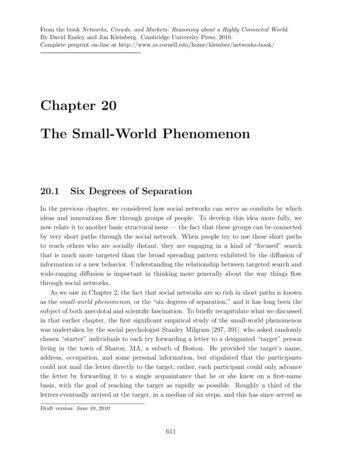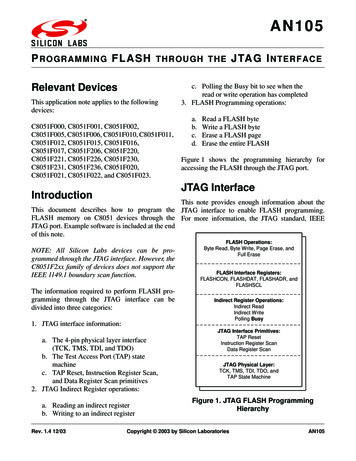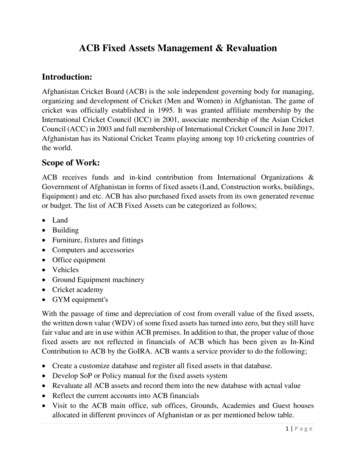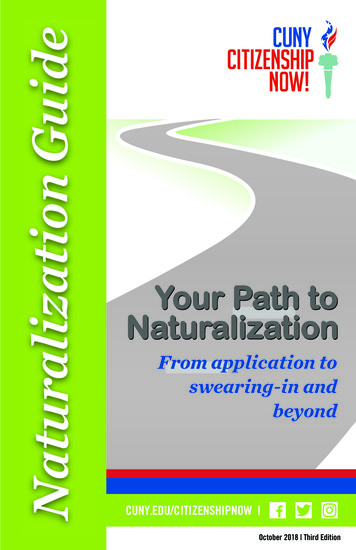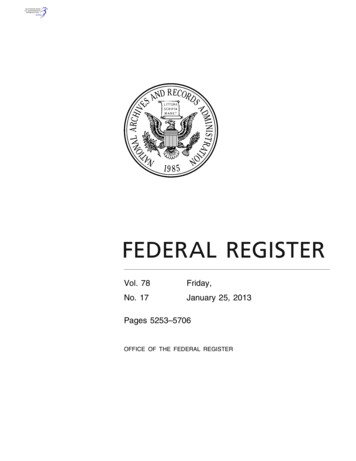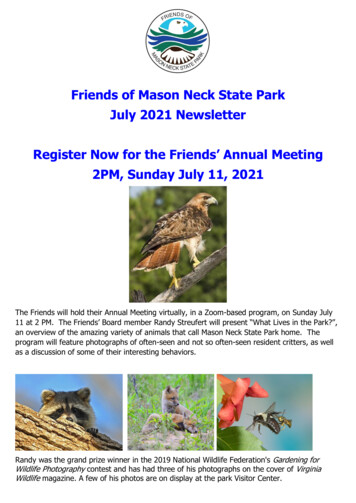
Transcription
Friends of Mason Neck State ParkJuly 2021 NewsletterRegister Now for the Friends’ Annual Meeting2PM, Sunday July 11, 2021The Friends will hold their Annual Meeting virtually, in a Zoom-based program, on Sunday July11 at 2 PM. The Friends’ Board member Randy Streufert will present “What Lives in the Park?”,an overview of the amazing variety of animals that call Mason Neck State Park home. Theprogram will feature photographs of often-seen and not so often-seen resident critters, as wellas a discussion of some of their interesting behaviors.Randy was the grand prize winner in the 2019 National Wildlife Federation's Gardening forWildlife Photography contest and has had three of his photographs on the cover of VirginiaWildlife magazine. A few of his photos are on display at the park Visitor Center.
Ericka Jackson, the park's Chief Ranger for Visitor Experience, will provide a brief discussion ofthe Park's aging well water system that has for many years provided all the water for the VisitorCenter, picnic area and on-site residences, and the plans for converting to the public watersystem.We'll begin the meeting with a short business session at which we elect a Board of Directors forthe coming year and Friend's President Hillary Clawson will provide a brief summary of theFriend's recent and upcoming activities. You can review the bios of the current Board ofDirectors, all of whom are standing for re-election, here.The Annual Meeting is open only to current members of the Friends. Members can register forthe event here. If you’re not a member, you can join for as little as 20 per year here. We’d loveto “see” you at the meeting.Critter(s) of the Month – TurtlesText and photos by Randy Streufert21 Eastern Painted Turtles enjoying a warm day in early MarchWho does not love turtles? Unlike their reptilian cousins (snakes, crocodilians, and lizards),nearly everyone finds them appealing. According to paleontologists, turtles, tortoises, andterrapins have inhabited the earth for 220 million years and are virtually unchanged since thedays of dinosaurs.
Turtles are most famous for their longevity; many of us have heard of giant tortoises being over150 years old. What may be surprising is that Virginia’s native Woodland Box Turtles have anaverage life span of 50 years, and a significant percentage live over 100 years. Yes, thoseturtles many of us stop to help get safely across the road can be older than our grandparents.Woodland Box TurtleThe Park is home to several species including Snapping Turtles, Spotted Turtles, Eastern PaintedTurtles, Northern Red-bellied Cooters, Southeastern Mud Turtles, and Woodland Box Turtles.The Woodland Box Turtle is Virginia’s only terrestrial turtle, spending the vast majority of itstime on land. Occasionally, one will be found swimming in a flooded area of the forest orcrossing a stream or pond.All other turtles in the park are aquatic, spending almost all their time in the water. SinceTurtles are ectothermic (cold-blooded), aquatic turtles are most often seen when basking on alog to soak up warmth from the sun.Southeastern Mud Turtle
Snapping TurtleFrom May to July, park visitors often see a single Southeastern Mud, Eastern Painted, and/orSnapping Turtle near the road. These are the females that leave the safety of the water to laytheir eggs.All three species exhibit similar behaviors for their egg-laying. The female drinks as much wateras she can, crawls up the bank and searches for a suitable place for her nest – ground unlikelyto flood and exposed to the sun. The ground next to the park’s roads often meets thosecriteria.Southeastern Mud TurtleFemale Eastern Painted Turtle
Once she’s selected her spot, she urinates and starts digging a hole with her hind feet. Herurine softens the ground, turning it to mud, which is easier for her to dig.When the hole is as deep as she can reach down, she lays her eggs. The Southeastern Mudand the Eastern Painted turtles lay about six eggs. Snapping Turtles lay an average of 20 to 40ping-pong ball sized eggs, but as many as 100 have been recorded.When the female is finished, she fills the hole back up, covering the eggs with mud. Then shemakes the area look as natural as she can by removing visual evidence of the nest site.Female almost finished filling the hole back inNest site immediately after the female finished.The only evidence of her work is the damp, slightly darker ground.
All her work is done with her hind feet. She never sees the hole, never sees her eggs, andnever even looks at the spot after she’s finished!If crows see where the female laid her eggs, they will swoop in as soon as she leaves and dig inthe still-soft earth for a meal of the eggs.If undisturbed, the eggs will hatch in late August to mid-September and the hatchlings will maketheir way out of the hole and crawl to the water.Eastern Painted Turtles hatchingSnapping Turtle hatching
Just-hatched Eastern Painted TurtleJust-hatched Southeastern Mud Turtle – A Daddy Long Legs happened to walk over it as the photo was taken.If you ever want to see a happy turtle, allow one to get into your garden and feast on a tomato.While driving into and out of the park, please be especially mindful of the small hard-to-seeturtles that may be crossing the road.The Virginia Department of Game and Inland Fisheries publication titled A Guide to the Turtlesof Virginia was the primary source for the information in this article as was the author’sexperience photographing the turtles here.
Please Help Support Mason Neck State ParkBy Joining the Friends’ Board of DirectorsDo you like what the Friends of Mason Neck State Park do for the Park? Would you like to helpus continue supporting it? The Friends have sponsored online programs throughout thePandemic, including the June 12 History Program and the Virtual Eagle Festival in May. We payfor all the programs for the Park’s annual Eagle Festival and provide extensive volunteersupport. We support the annual Park After Dark event and we sponsor several Friendsprograms at the Park, such as Owl Moon and Swanfall, our annual holiday event. We’ve alsobeen instrumental in obtaining additional state funding for the Park, including funding foradditional Park Staff, and provide funding to enable underserved youth to experience Parkprograms.The Friends need additional Board members if we are going to continue to work on behalf of thePark. Do you have some time to help us continue our efforts? If you are interested in joiningthe Board, please send an email to FriendsofMasonNeckStatePark@gmail.com. Thanks!The Friends Participated in the Mount VernonDistrict 3rd Annual Environment ExpoSeveral members of the Friends staffed the Friend’s tent at the Mount Vernon District annualEnvironment Expo on June 26. We featured Board member Randy Streufert’s photographs ofwildlife in the park and provided information on the park’s programs. The Friends alsosponsored two programs by Secret Garden Birds and Bees featuring live owls and a hawk, andFriends’ Board member Pam Cressey led a Meditation Walk.
The Friends Supported the Park’sYouth Conservation Corps TeamEight Youth Conservation Corps high school students and two counselors arrived at Mason NeckState Park on June 21 to begin three weeks of work improving the park. They’ll be working onfence repair and spreading mulch at the picnic area and the Visitor Center.The Friends provided lunch to the team and Board member Randy Streufert gave them anorientation to the park.Help the Friends Maintainthe Park’s Pollinator Gardens!
Mason Neck State Park’s pollinator gardens are important to helping to sustain the insects thatare vital to our ecosystem. However, the gardens need caretakers to keep them in good shape.Are you able to help out in the gardens from time to time? Send us an email atFriendsofMasonNeckStatePark@gmail.com and we’ll contact you about how you can help tokeep the gardens beautiful and useful.Please Help Us SupportMason Neck State Park!If you are already a member of the Friends of Mason Neck State Park, Thank You! Yourmembership dues and donations help us to support the Park's activities, and also enable us tofund special events such as our Owl Moon evening each fall and the annual Swanfall HolidayProgram at the Jammes House each December. We've had to replace our in-person activitieswith virtual programs for the past few months, but we’ll return to in-person events soon.If you aren't a member, or your membership has lapsed, you can become a member at Join theFriends of Mason Neck State Park.You can also donate to the Friends here.
Critter(s) of the Month – Turtles Text and photos by Randy Streufert 21 Eastern Painted Turtles enjoying a warm day in early March Who does not love turtles? Unlike their reptilian cousins (snakes, crocodilians, and lizards), nearly everyone finds them appeali





